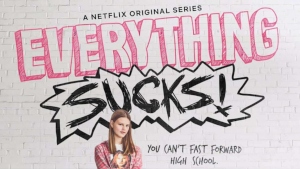“Everything Sucks!” (Netflix), the first season of which includes 10 half-hour episodes, starts off like a second-rate “Freaks and Geeks” but eventually strikes painfully accurate notes about first love and high school crushes. By the time the strains of Spacehog’s “In the Meantime” play over the closing credits of episode 10, the show has learned to lean into its dramatic rather than comedic beats, and I was won over. (It’s still inferior to “F&G” – which I am now inspired to rewatch — but everything is.)
Created by Ben York Jones and Michael Mohan, “Everything Sucks!” is set at fictional Boring High School in Boring, Ore. (which is a real town, although the series was filmed in Portland). The town is so bland that people stop to take photos by the welcome sign, then turn around. Jones was born in 1984 (I can’t find Mohan’s age), and I admit there is a part of me that says “Dang Millennials!” when something strikes me as off-point. For example, the drama club rules the school, and that wasn’t a thing until the “Glee” era of the Aughts, was it? The directors also like to zoom in on Surge soda cans and Zima bottles and slow-loading internet pages to emphasize artifacts of the time period, rather than just letting things flow.
But: the characters. Oh the characters (who – I must admit – are a few years younger than me and therefore technically millennials, although just barely). My heart breaks for aspiring filmmaker Luke (Jahi Di’Allo Winston), who is immediately smitten with fellow AV Club member Kate (Peyton Kennedy), who we as an audience quickly learn is gay. To her credit, Kate doesn’t string Luke along all that much, but – perhaps in a nod to the pre-“woke” times – he doesn’t fully absorb the fact of her sexuality. Perhaps he thinks it’s a phase or perhaps he sees Kate as the ultimate safe first girlfriend. When they agree to pretend to be a couple, he says he’ll use the code-phrase “banana slug” if he ever falls in love with her.
So we know what’s coming, but it’s still a pure moment of heartbreak when he observes Kate playing “Rocket Man” on the piano in a pretty dress and mumbles “banana slug.” Although it’s a weird narrative choice to have Luke’s pal McQuaid (Rio Mangini) also fall for a girl who prefers girls – drama clubber Emaline (Sydney Sweeney) – the arc is handled with an even more deft touch this time around. Thirty seconds of Emaline paying attention to him in the woods and he is completely taken in; for her, there is no magic moment. I suspect a lot of guys can relate to Luke’s and McQuaid’s travails (which isn’t to say that every girl who rejects you is a lesbian, although that does play to a primal assumption).
Additionally, Jones and Mohan give a nod to the missed signals that could’ve led to happiness for our nerd heroes if their minds worked on multiple tracks. After the climactic screening of the AV/drama club movie “Intergalactic Lust” (the making of which provides the season’s overarching thread), McQuaid ditches girls who want his autograph to chase after Emaline. The third member of the main trio of guys, Tyler (Quinn Liebling), cares more about ping-pong than girls, which is why he fails to notice the hints dropped by Leslie (Abi Brittle).

Demonstrating that not EVERYTHING sucks, the show allows one guy to get the girl. I appreciate the non-stereotypical portrayal of a principal in the form of Ken (Patch Darragh), a sweet guy who doesn’t notice the signs of his daughter’s sexuality. (When he catches Kate looking at a Playboy, he assumes she is worrying about looking like the models.) I was rooting the whole way for him to find happiness with Luke’s mom, Sherry (Claudine Mboligikpelani Nako).
Am I reading too much into “Everything Sucks!” to say that it puts a special shine on the lesbian relationship? I almost want to say “Hey, straight people have feelings, too!,” and I balk at Luke’s self-flagellation about how everyone (Kate) has their own story, not just the main character (Luke). Still, I suppose there is something very 1996 about it. Gay kids are the stars of their high schools today (if TV portrayals reflect reality), but as recently as 20 years ago, they leaned toward keeping their sexual orientation under wraps. And, indeed, Kate’s coming out has been pushed to Season 2.
If someone asked me for the perfect portrayal of high school life in the 1990s, I’d say “My So-Called Life” or “Buffy” or “Dawson’s Creek.” Those series glamorize the fears, pain and ennui of the pre-millennium teen experience, but they struck me at the time as emotionally true, which is why I loved and embraced them. (So did 1999’s “F&G,” but it’s set in 1980, so I don’t feel right claiming ownership on behalf of my generation.)
In some ways, though, “Everything Sucks!” is a truer portrayal of 1996. Artifacts of the time – Surge and Zima and the old Mountain Dew and Doritos logos – are peppered about, but there’s no wider meaning attached. Music is the show’s ace in the hole. Luke gets Oasis’ “(What’s the Story) Morning Glory?” from his Columbia House CD Club. Luke and Kate attend a Tori Amos concert. Ken dances and mumbles along to “Breakfast at Tiffany’s,” from a Deep Blue Something album that everyone bought and quickly turned in to Disc-Go-Round (or whatever your local secondhand CD store was).
When I hear these songs, I think about what they meant to me and my friends, and I don’t see those specific feelings reflected by the characters. (Kate’s connection to Amos is the best weaving of music into an arc. Of course, it’s a bit on the nose, which might be an example of why “Everything Sucks!” is sometimes classified as a parody, although I don’t think it commits to that genre.)
Except for The Verve Pipe’s “Freshmen” elevating the final episode, “Everything Sucks!” embraces poppier tunes. I wonder if some Seattle grunge and post-grunge bands would’ve fit the soundtrack better or if that would’ve come off as too obvious. I feel like the show ended up going in a less comedic direction than was originally intended, and darker songs would’ve been better choices.
At any rate, the time-period references tend to feel a bit flat, but if I’m being honest, the real-world mid-1990s high school experience wasn’t as beautifully pain-wracked as “My So-Called Life.” We experienced the same BS that has afflicted everyone from the “Freaks and Geeks” of 1980 to the kids in the much-hyped “Rise” (except we weren’t “woke” and the theater geeks and gay kids of our time stayed behind the curtain). Heartbreak knows no categorical boundaries, generational or otherwise.

